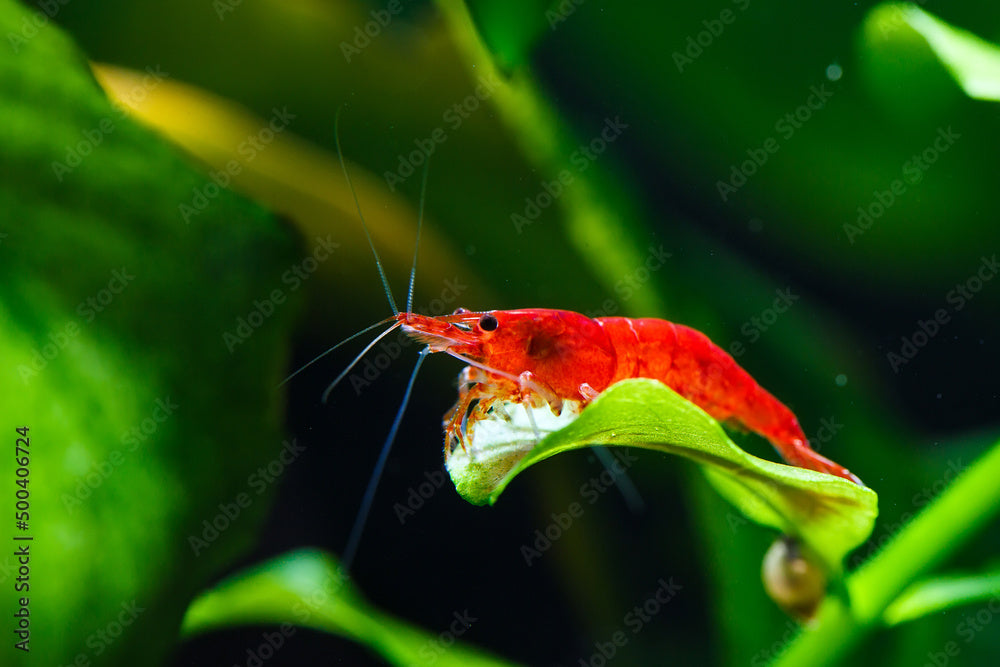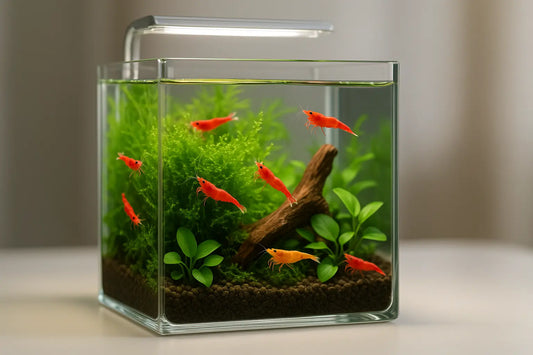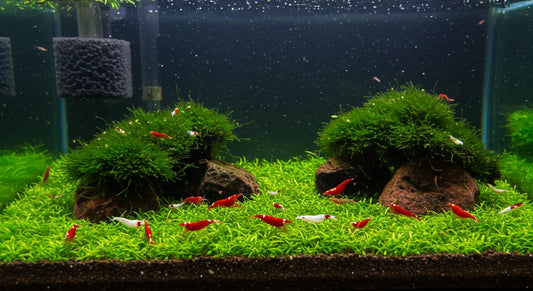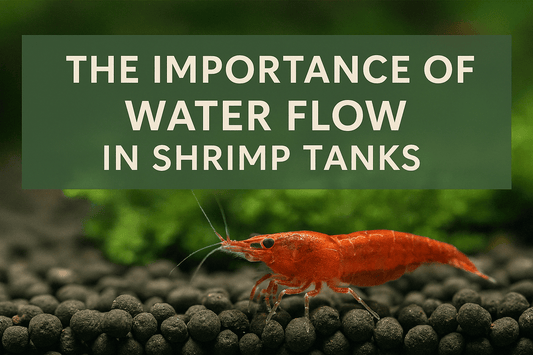
Caridina vs. Neocaridina Shrimp: Essential Guide for Aquarists
Adding shrimp to your aquarium is a fantastic way to bring color and life to your setup, and two of the most popular choices are Caridina and Neocaridina shrimp. These freshwater shrimp types each have their own charm, care needs, and quirks, making them perfect for different kinds of aquarists. Whether you’re just starting your shrimp-keeping journey or you’re an experienced hobbyist looking for a new challenge, this guide will help you understand the differences between Caridina and Neocaridina shrimp and decide which is right for your shrimp aquarium.
Which Shrimp Should You Choose?
Deciding between Caridina and Neocaridina shrimp comes down to your experience level and how your tank is set up. Here’s a breakdown to guide your choice:
- For Beginners: If you’re new to shrimp keeping, Neocaridina shrimp are a great pick. They’re resilient and can thrive in a wide range of water conditions, making them more forgiving if you’re still learning the ropes.
- For Experienced Aquarists: Caridina shrimp might be your match if you’re up for a challenge. Their stunning patterns—like the iconic red and white of Crystal Red Shrimp—and rewarding breeding process make them a favorite among advanced shrimp keepers.
- Tank Setup Considerations: Caridina shrimp need stable, well-maintained tanks with specific water parameters, like soft, acidic water. Neocaridina shrimp, on the other hand, are more adaptable and can handle varied conditions, including slightly harder water.
When setting up your shrimp aquarium, it’s all about matching the shrimp to your tank’s environment. For beginner shrimp keepers, Neocaridina shrimp are ideal due to their adaptable nature. If you’re into advanced shrimp keeping and love tinkering with water chemistry, Caridina shrimp offer a beautiful and exciting option.
1. Origins and Background
Caridina Shrimp
Caridina shrimp hail from the Caridina genus, with origins across Asia, including Japan, Taiwan, and the Philippines. You’ve likely seen popular varieties like Crystal Red Shrimp, Blue Bolt Shrimp, and Blue Shadow Panda Shrimp. These shrimp are accustomed to specific habitats in the wild, which is why they demand precise care in captivity.
Neocaridina Shrimp
Neocaridina shrimp, from the Neocaridina genus, are native to Southeast Asia, particularly Taiwan. The star of this group is Neocaridina davidi, available in vibrant varieties like Bloody Mary Shrimp, Blue Dream Shrimp, and Green Jade Shrimp. Their adaptability and bold colors make them a hit with aquarists of all levels.
2. Appearance
Caridina Shrimp
- Size: Typically 1 to 1.5 inches (2.5 to 4 cm).
- Color and Patterns: Known for intricate, eye-catching patterns—like the delicate red and white bands of Crystal Red Shrimp.
- Body Shape: Slim and delicate, giving them a refined look.
Neocaridina Shrimp
- Size: A bit larger, reaching 1.5 to 2 inches (4 to 5 cm).
- Color and Patterns: Famous for bright, solid colors—think the deep red of Bloody Mary Shrimp or the vivid blue of Blue Dream Shrimp.
- Body Shape: Sturdier and more robust, built to handle a variety of conditions.
3. Care and Environment
Keeping your shrimp happy and healthy starts with understanding their specific needs. Here’s a deep dive into the care and environment requirements for both types, complete with water parameters and practical tips.
Caridina Shrimp Care
-
Water Parameters:
- pH: 6.0-6.8
- GH: 4-6
- KH: 0-2
- TDS: 100-200
- Temperature: 68-74°F (20-23°C)
- Tank Setup: These shrimp thrive in stable setups with live plants, driftwood, and gentle filtration. They’re sensitive to water changes, so keep them small and gradual. Need help? Check out our shrimp tank setup guide.
- Feeding: Offer high-quality shrimp pellets, blanched veggies (like spinach or zucchini), and occasional protein treats. See our shrimp feeding guide for more ideas.
- Common Issues: Watch out for ammonia spikes or sudden shifts in parameters—they can stress Caridina shrimp out. Regular water testing is a must.
Neocaridina Shrimp Care
-
Water Parameters:
- pH: 6.5-8.0
- GH: 6-8
- KH: 3-5
- TDS: 150-250
- Temperature: 65-78°F (18-26°C)
- Tank Setup: They’re flexible and adapt to many setups, though they love plants and hiding spots. They’re tougher than Caridina, but consistent maintenance keeps them thriving.
- Feeding: Omnivores that enjoy algae wafers, biofilm, and occasional veggies. Try our recommended shrimp food for a balanced diet.
- Common Issues: Hardy overall, but prolonged poor water quality can take a toll. Keep up with routine care to avoid problems.
Pro Tip: For both types, use drip acclimation when introducing them to your tank—it makes the transition smoother and reduces stress.
4. Breeding Shrimp
Breeding shrimp is a rewarding part of the hobby, and both Caridina and Neocaridina offer unique experiences. Here’s how to set them up for success.
Breeding Caridina Shrimp
Breeding Caridina shrimp takes some effort but pays off with gorgeous fry:
- Setup: Use a separate breeding tank with soft, acidic water and plenty of hiding spots like moss or fine-leaf plants.
- Water Conditions: Stick to their ideal parameters (pH 6.0-6.8, TDS 100-200) and keep everything stable.
- Care for Fry: The tiny fry are sensitive and may need brackish water for some species. Feed them powdered food or biofilm.
- Tips: Want step-by-step help? Our 3-step guide to successful Caridina shrimp breeding has you covered.
Breeding Neocaridina Shrimp
Neocaridina shrimp make breeding a breeze:
- Setup: They’ll breed happily in a community tank as long as the water’s clean and there’s cover for fry—like moss or dense plants.
- Water Conditions: No special tweaks needed beyond their standard care range.
- Care for Fry: Fry hatch as mini adults and are easy to raise—just keep them safe from hungry tank mates.
- Tips: Add extra hiding spots to boost fry survival rates, especially if fish are in the tank.
5. Tank Mates
Picking the right tank mates keeps your shrimp safe and your aquarium peaceful.
Caridina Shrimp
- Compatibility: Stick to small, peaceful fish or other shrimp. Avoid anything big or aggressive that might snack on them.
- Examples: Neon tetras, small rasboras, or fellow Caridina shrimp.
Neocaridina Shrimp
- Compatibility: More versatile and can handle a broader range of companions, though baby shrimp might still get eaten by fish.
- Examples: Guppies, endlers, or snails work well.
Comparison Table: Caridina vs. Neocaridina Shrimp
Here’s a quick-glance table to compare the two:
| Aspect | Caridina Shrimp | Neocaridina Shrimp |
|---|---|---|
| pH | 6.0-6.8 | 6.5-8.0 |
| GH | 4-6 | 6-8 |
| KH | 0-2 | 3-5 |
| TDS | 100-200 | 150-250 |
| Temperature | 68-74°F (20-23°C) | 65-78°F (18-26°C) |
| Size | 1-1.5 inches | 1.5-2 inches |
| Color Variety | Intricate patterns (e.g., Crystal Red) | Bright, solid colors (e.g., Bloody Mary) |
| Breeding | Challenging; needs specific setup | Easy; breeds in community tanks |
| Tank Mates | Small, peaceful fish | Wide variety; more adaptable |
Frequently Asked Questions (FAQ)
Got questions? Here are answers to some common ones about Caridina and Neocaridina shrimp:
- Which shrimp is easier to care for? Neocaridina shrimp win here—they’re more adaptable and forgiving, perfect for beginners.
- Can Caridina and Neocaridina shrimp live together? Not really. Their water parameter needs clash, so mixing them could stress one or both out.
- What are the best tank mates for Caridina shrimp? Small, peaceful fish like neon tetras or other shrimp species. Skip anything that might see them as a snack.
Conclusion
Whether you go with Caridina or Neocaridina shrimp, you’re in for a treat. Caridina shrimp bring dazzling patterns and a fun challenge, needing buffering soil and remineralized RODI water to shine. Neocaridina shrimp offer bold colors and easy care, making them a fantastic choice for beginners and pros alike.
By knowing their differences, you can set up the perfect shrimp tank setup and watch these little wonders thrive. Ready to dive in? Browse our Caridina shrimp collection or Neocaridina shrimp collection to find your new favorites. Need advice? Drop us a line at teacherspetnw@gmail.com—we’d love to help!


